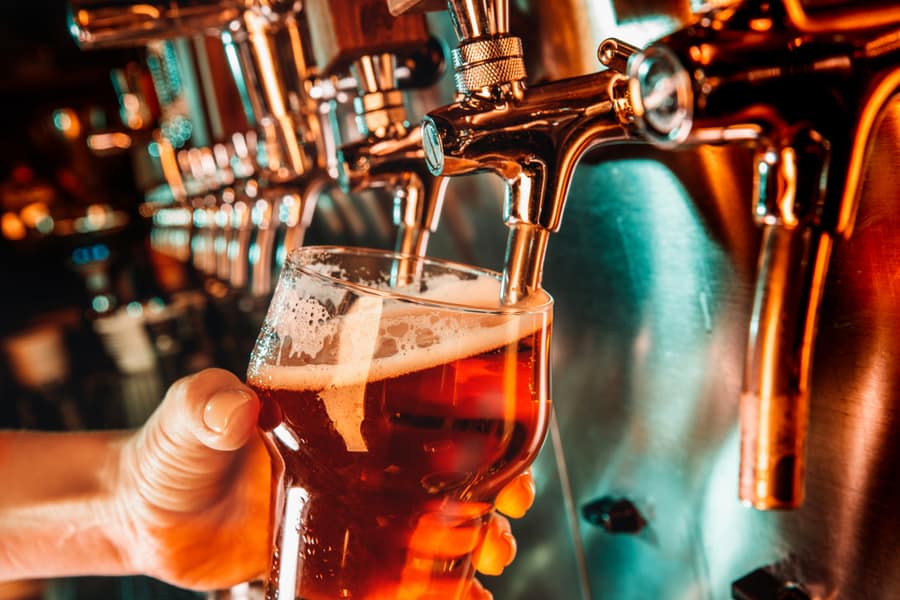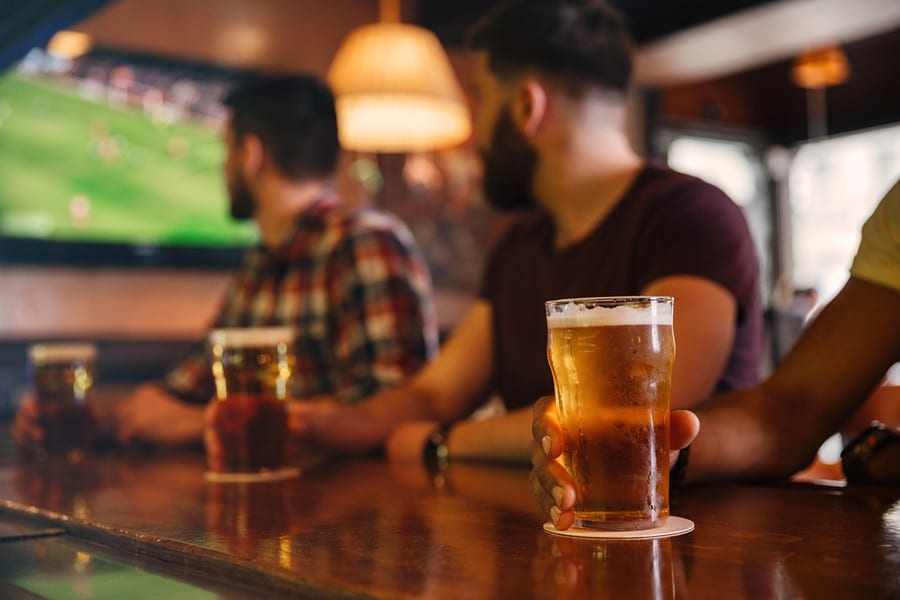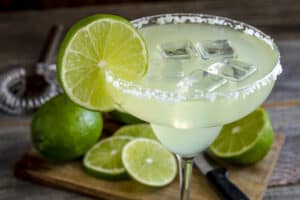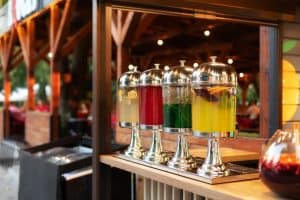
There’s nothing better than walking into your favorite bar at the end of the week and winding down with an ice-cold beer with friends, right?
When the bill arrives, you suddenly notice that your neighborhood bar charges much more for your favorite beer than you would pay at your local supermarket.
You start making sums and wonder how much they charge for a beer at the bar.
Bars are businesses and need to turn a profit. On average, a local US beer is marked up around three times the cost price, which is, admittedly, a vast profit. Consider that this profit will pay for numerous expenses to run the bar and to provide you with a service.
A beer at a bar in one of the ten most populous states in the US will cost, on average, between $6 and $9 per 500 ml/16 fl oz bottle of beer. In one of the least populous states, the average price is between $5 and $7 for the same beer bottle.
First, we’ll look at the average cost of a bottle of beer at the supermarket in the ten most and least populous states in the US to give us a springboard from which to work. Next, we’ll examine the average price of the same bottle of beer in a neighborhood bar. Finally, we’ll look into how bars arrive at their pricing and provide insight into how they derive their pricing per beer.
Cost of a Beer at a Supermarket

For this comparison, we had to select the following parameters and data sets:
- We’ve used average prices from Expatisan to determine the supermarket price for each city listed below, based on a 16 fl oz / 500 ml bottle of beer.
- We’ve listed the top 10 most populous and least US states as of 2023 to provide a fair comparison between the two.
| Rank | Most Populous | City | 500 ml / 16 fl oz | Rank | Least Populous | City | 500 ml / 16 fl oz |
|---|---|---|---|---|---|---|---|
| 1 | California | San Francisco | $3.75 | 1 | New Hampshire | Manchester | $1.61 |
| 2 | Texas | Houston | $2.64 | 2 | Maine | Portland | $3.39 |
| 3 | Florida | Cocoa Beach | $2.64 | 3 | Montana | Billings | $3.27 |
| 4 | New York | New York City | $3.32 | 4 | Rhode Island | Providence | $2.03 |
| 5 | Pennsylvania | Pittsburgh | $3.40 | 5 | Delaware | Wilmington | $3.75 |
| 6 | Illinois | Chicago | $2.83 | 6 | South Dakota | Sioux Falls | $2.54 |
| 7 | Ohio | Columbus | $6.00 | 7 | North Dakota | Bismarck | $4.46 |
| 8 | Georgia | Atlanta | $2.75 | 8 | Alaska | Anchorage | $3.08 |
| 9 | North Carolina | Raleigh | $3.13 | 9 | Vermont | Burlington | $4.94 |
| 10 | Michigan | Ann Arbor | $2.70 | 10 | Wyoming | Cheyenne | $2.14 |
The cost of raw ingredients has been going up and as such on-the-shelf prices for craft and regular beer have also been rising, craft beer more so.
The average price for a six-pack of craft beer is between $8 and $12, and if you wonder why it’s so expensive, take a look at the pricing breakdown and factors that influence the price.
We’ve seen this list of mass-market beers that still taste great without breaking the bank—perfect for when spring and summer roll around again!
Cost of a Beer at a Bar

The cost of a beer at a bar varies. Various factors come into play: the type of bar you’re visiting, the location—upmarket area or in town, and the time of the day can even influence the price.
We all know that beer prices are higher at a bar when compared to a grocery store. A bar has numerous expenses, and that’s why they put a markup on the price of beer—rent, staff salaries, and other overhead expenses all need to be covered.
What out-of-town visitors at bars sometimes forget is the local state tax is also factored into the price of their beer.
We’ve again turned to Expatisan to find the average beer bottle price in a neighborhood pub or bar for you. Remember, higher-class establishments like a hotel lobby bar or a bar in a high-end area will have even higher prices.
| Rank | Most Populous | City | 500 ml / 16 fl oz | Rank | Least Populous | City | 500 ml / 16 fl oz |
|---|---|---|---|---|---|---|---|
| 1 | California | San Francisco | $9.00 | 1 | New Hampshire | Manchester | $7.97 |
| 2 | Texas | Houston | $5.21 | 2 | Maine | Portland | $6.03 |
| 3 | Florida | Cocoa Beach | $4.60 | 3 | Montana | Billings | $5.39 |
| 4 | New York | New York City | $8.00 | 4 | Rhode Island | Providence | $5.57 |
| 5 | Pennsylvania | Pittsburgh | $4.58 | 5 | Delaware | Wilmington | $5.10 |
| 6 | Illinois | Chicago | $5.68 | 6 | South Dakota | Sioux Falls | $4.54 |
| 7 | Ohio | Columbus | $6.00 | 7 | North Dakota | Bismarck | $4.24 |
| 8 | Georgia | Atlanta | $9.00 | 8 | Alaska | Anchorage | $7 |
| 9 | North Carolina | Raleigh | $5.17 | 9 | Vermont | Burlington | $5.52 |
| 10 | Michigan | Ann Arbor | $5.47 | 10 | Wyoming | Cheyenne | $3.52 |
How Do Bars Get Their Pricing?
This section is designed to give you a better idea of how bars actually price their beer.
Bar owners must factor in many variables when they price their goods, especially alcohol. While alcohol sales are usually the one item on the list that attracts the most significant profit margins, pricing isn’t made up on a whim.
Whether it is a dedicated bar or pub, or a bar at a restaurant or in a hotel, they all need to turn a profit.
A skilled bar manager is worth more than their weight in gold because they can make or break the bar’s profit margins. They use unique formulas and calculations to get the most bang for their dollar from every drop you serve at the bar.
On average, a bar will charge a beer three times the regular retail price, or 300%. However, this formula doesn’t hold true for all kinds of beer.
This means when a bar buys beer at $1 per can or bottle, they’ll charge between $3.3 and $5 per beer. But there are other types of beer that will attract different pricing.
When a bar specializes in craft beers, you can expect to pay a lot more for a beer. The factors that influence the price of craft beer are the purchase cost and the exclusivity of the beer.
The factor that drives the expense up even more is staff training—they need to open beers to let the staff have a taste of what’s on offer so they can guide you through their menus.
With microbreweries popping up everywhere, their menus can constantly change. They’ll need to update their pricing accordingly and retrain staff members in the new offerings.
Some bars have a specialized cicerone, and they’ll also need to earn a salary to guide you to the best option for your palate.
Imported beers attract even more fluctuations in price, for example, exchange rates go up right before an order is shipped, and the bar owner will have to cover these costs.
Staff needs to be trained on new imports, which inevitably means bottles will have to be opened and profits lost. New products need to be sought to bring us, the customers, the world’s best choices.
Conclusion
Before you balk at the prices bars charge for a beer, remember that a bar is a business, and a business needs to make a profit. Although beers are marked up by sometimes as much as 300%, it does not mean the bar actually takes all that profit home.
Various expenses still need to be paid from that profit. If your bar isn’t making a profit, they won’t be able to serve you and your friends your favorite cocktails and drinks.
Be nice, order a pint at your favorite neighborhood bar, and support a local business and family.








